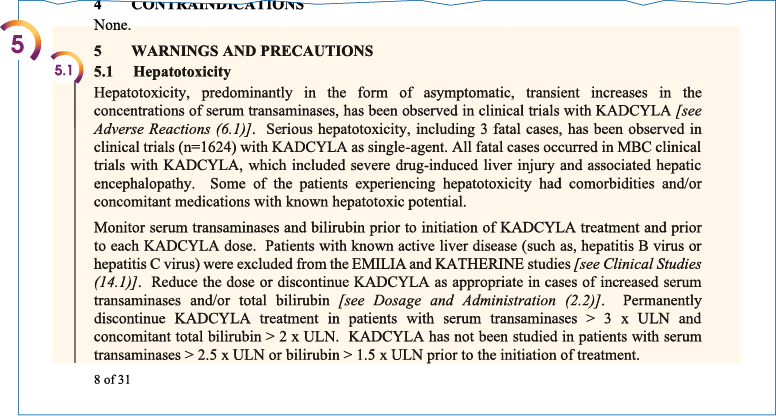The Warnings and Precautions section of the Prescribing Information (Section 5) is comprised of 9 subsections that discuss potential risks associated with the use of KADCYLA. Three of the warnings and precautions are included in the boxed warning: hepatotoxicity, left ventricular dysfunction, and embryo-fetal toxicity.
Section 5.1 Hepatotoxicity
Hepatotoxicity, predominantly in the form of asymptomatic, transient increases in the concentrations of serum transaminases, has been observed in clinical trials with KADCYLA. Serious hepatotoxicity, including 3 fatal cases, has been reported in clinical trials with KADCYLA as a single agent. All fatal cases occurred in MBC clinical trials with KADCYLA, which included severe drug-induced liver injury and associated hepatic encephalopathy. Some of the patients experiencing hepatotoxicity had comorbidities and/or concomitant medications with known hepatotoxic potential.
Serum transaminases and bilirubin need to be monitored prior to initiation of KADCYLA treatment and prior to each KADCYLA dose. Patients with known active liver disease (such as hepatitis B virus or hepatitis C virus) were excluded from the EMILIA and KATHERINE studies. Physicians should reduce the dose or discontinue KADCYLA as appropriate in cases of increased serum transaminases and/or total bilirubin. In patients with serum transaminases >3 times the upper limit of normal (ULN) and concomitant total bilirubin >2 times ULN, physicians should permanently discontinue KADCYLA treatment. KADCYLA has not been studied in patients with serum transaminases >2.5 × ULN or bilirubin >1.5 × ULN prior to the initiation of treatment.
In clinical trials for KADCYLA, cases of nodular regenerative hyperplasia (NRH) of the liver have been identified from liver biopsies (5 cases out of 1624 treated patients, 1 of which was fatal). Two of these 5 cases of NRH were observed in EMILIA and 2 were observed in KATHERINE. NRH is a rare liver condition characterized by widespread benign transformation of hepatic parenchyma into small regenerative nodules. NRH may lead to noncirrhotic portal hypertension.The diagnosis of NRH can be confirmed only by histopathology. NRH should be considered in all patients with clinical symptoms of portal hypertension and/or cirrhosis-like pattern seen on the computed tomography (CT) scan of the liver but with normal transaminases and no other manifestations of cirrhosis. KADCYLA treatment must be permanently discontinued upon diagnosis of NRH.

Section 5.2 Left Ventricular Dysfunction
Patients treated with KADCYLA are at increased risk of developing left ventricular dysfunction. A decrease of left ventricular ejection fraction (LVEF) to <40% has been observed in patients treated with KADCYLA. In the EMILIA trial, left ventricular dysfunction occurred in 1.8% of patients in the KADCYLA-treated group and 3.3% of patients in the lapatinib plus capecitabine-treated group. In KATHERINE, left ventricular dysfunction occurred in 0.4% of patients in the KADCYLA-treated group and 0.6% of patients in the trastuzumab-treated group.
Physicians should assess LVEF prior to initiation of KADCYLA and at regular intervals (every 3 months) during treatment to ensure the LVEF is within the institution's normal limits. Treatment with KADCYLA has not been studied in patients with LVEF <50% prior to initiation of treatment.
- For patients with MBC, withhold KADCYLA and repeat LVEF assessment within approximately 3 weeks if, at routine monitoring, LVEF is <40%, or is 40% to 45% with a 10% or greater absolute decrease below the pretreatment value. Permanently discontinue KADCYLA if the LVEF has not improved or has declined further.
- For patients with EBC, withhold KADCYLA and repeat LVEF assessment within approximately 3 weeks if, at routine monitoring, LVEF is <45%, or is 45% to 49% with a 10% or greater absolute decrease below the pretreatment value. Permanently discontinue KADCYLA if the LVEF has not improved or has declined further.
- Patients with a history of symptomatic congestive heart failure, serious cardiac arrhythmia, or history of myocardial infarction or unstable angina within 6 months were excluded from the EMILIA and KATHERINE studies.

Section 5.3 Embryo-Fetal Toxicity
KADCYLA can cause fetal harm when administered to a pregnant woman. Cases of oligohydramnios and oligohydramnios sequence manifesting as pulmonary hypoplasia, skeletal abnormalities, and neonatal death were observed in the post-marketing setting in patients treated with trastuzumab, the antibody component of KADCYLA. DM1, the cytotoxic component of KADCYLA, can cause embryo-fetal toxicity based on its mechanism of action.
HCPs should verify the pregnancy status of females of reproductive potential prior to initiation of KADCYLA. Pregnant women and females of reproductive potential should be warned that exposure to KADCYLA during pregnancy or within 7 months prior to conception can result in fetal harm.

Sections 5.4 to 5.9 Other Warnings and Precautions
Select the tabs for other warnings and precautions for KADCYLA administration:
Cases of interstitial lung disease (ILD), including pneumonitis, some leading to acute respiratory distress syndrome or fatal outcome have been reported in clinical trials with KADCYLA. Signs and symptoms include dyspnea, cough, fatigue, and pulmonary infiltrates.
In patients with MBC, pneumonitis was reported at an incidence of 0.8% (7 out of 884 treated patients), with one case of Grade 3 pneumonitis. The overall incidence of pneumonitis was 1.2% in EMILIA. In KATHERINE, pneumonitis was reported at an incidence of 1.1% (8 out of 740 patients treated with KADCYLA), with one case of Grade 3 pneumonitis.
Radiation pneumonitis was reported at an incidence of 1.8% (11 out of 623 patients treated with adjuvant radiotherapy and KADCYLA), with 2 cases of Grade 3 radiation pneumonitis.
Treatment with KADCLYA should be permanently discontinued in patients diagnosed with ILD or pneumonitis. For patients with radiation pneumonitis in the adjuvant setting, KADCYLA should be permanently discontinued for Grade 3 or for Grade 2 not responding to standard treatment.
Patients with dyspnea at rest due to complications of advanced malignancy, co-morbidities, and receiving concurrent pulmonary radiation therapy may be at increased risk of pulmonary toxicity.
Treatment with KADCYLA has not been studied in patients who had trastuzumab permanently discontinued due to infusion-related reactions (IRRs) and/or hypersensitivity; treatment with KADCYLA is not recommended for these patients.
Infusion-related reactions, characterized by one or more of the following symptoms – flushing, chills, pyrexia, dyspnea, hypotension, wheezing, bronchospasm, and tachycardia have been reported in clinical trials of KADCYLA. In EMILIA, the overall incidence of IRRs in patients treated with KADCYLA was 1.4%. In KATHERINE, the overall incidence of IRRs in patients treated with KADCYLA was 1.6%. In most patients, these reactions resolved over the course of several hours to a day after the infusion was terminated. KADCYLA treatment should be interrupted in patients with severe IRR. KADCYLA treatment should be permanently discontinued in the event of a life-threatening IRR. Patients should be observed closely for IRR reactions, especially during the first infusion.
One case of a serious, allergic/anaphylactic-like reaction has been observed in clinical trials of single-agent KADCYLA. Medications to treat such reactions, as well as emergency equipment, should be available for immediate use.
Cases of hemorrhagic events, including central nervous system, respiratory, and gastrointestinal hemorrhage, have been reported in clinical trials with KADCYLA. Some of these bleeding events resulted in fatal outcomes. In EMILIA, the overall incidence of hemorrhage was 32% in the KADCYLA-treated group and 16% in the lapatinib plus capecitabine-treated group. The incidence of Grade ≥ 3 hemorrhage was 1.8% in the KADCYLA-treated group and 0.8% in the lapatinib plus capecitabine-treated group. In KATHERINE, the overall incidence of hemorrhage was 29% in the KADCYLA-treated group and 10% in the trastuzumab-treated group. The incidence of Grade ≥ 3 hemorrhage was 0.4% in the KADCYLA-treated group, with one fatal case of intracranial hemorrhage, and 0.3% in the trastuzumab-treated group. Although, in some of the observed cases the patients were also receiving anti-coagulation therapy, antiplatelet therapy, or had thrombocytopenia, in others there were no known additional risk factors. Health care providers should use caution with these agents and consider additional monitoring when concomitant use is medically necessary.
Thrombocytopenia, or decreased platelet count, was reported in clinical trials of KADCYLA (145 of 1624 treated patients with Grade ≥ 3; 494 of 1624 treated patients with any Grade). The majority of these patients had Grade 1 or 2 events (< LLN to ≥50,000/mm3) with the nadir occurring by day 8 and generally improving to Grade 0 or 1 (≥75,000/mm3) by the next scheduled dose. In clinical trials of KADCYLA, the incidence and severity of thrombocytopenia were higher in Asian patients.
In EMILIA, the overall incidence of thrombocytopenia was 31% in the KADCYLA-treated group and 3.3% in the lapatinib plus capecitabine-treated group. The incidence of Grade ≥3 thrombocytopenia was 15% in the KADCYLA-treated group and 0.4% in the lapatinib plus capecitabine-treated group. In Asian patients, the incidence of Grade ≥3 thrombocytopenia was 45% in the KADCYLA-treated group and 1.3% in the lapatinib plus capecitabine-treated group.
In KATHERINE, the overall incidence of thrombocytopenia was 29% in the KADCYLA-treated group and 2.4% in the trastuzumab-treated group. The incidence of Grade ≥3 thrombocytopenia was 6% in the KADCYLA-treated group and 0.3% in the trastuzumab-treated group. In Asian patients, the incidence of Grade ≥3 thrombocytopenia was 19% in the KADCYLA-treated group and 0% in the trastuzumab-treated group. The overall incidence of thrombocytopenia in the KADCYLA-treated group for Asian patients was 50%.
Health care providers should monitor platelet counts prior to initiation of KADCYLA and prior to each KADCYLA dose. KADCYLA has not been studied in patients with platelet counts <100,000/mm3 prior to initiation of treatment. In the event of decreased platelet count to Grade ≥3 (<50,000/mm3) KADCYLA should not be administered until platelet counts recover to Grade 1 (≥75,000/mm3). Closely monitor patients with thrombocytopenia (<100,000/mm3) and patients on anti-coagulant treatment during treatment with KADCYLA
Peripheral neuropathy, mainly as Grade 1 and predominantly sensory, was reported in clinical trials of KADCYLA (26 of 1624 treated patients with Grade ≥3; 435 of 1624 treated patients with any Grade). In EMILIA, the overall incidence of peripheral neuropathy was 21% in the KADCYLA-treated group and 14% in the lapatinib plus capecitabine-treated group. The incidence of Grade ≥3 peripheral neuropathy was 2.2% in the KADCYLA-treated group and 0.2% in the lapatinib plus capecitabine-treated group. In KATHERINE, the overall incidence of peripheral neuropathy was 32% in the KADCYLA-treated group and 17% in the trastuzumab-treated group. Peripheral neuropathy, including sensory and motor peripheral neuropathy, for KADCYLA treated patients 30% of cases were not resolved at the time of the primary invasive disease-free survival (iDFS) analysis for KATHERINE. The incidence of Grade ≥3 peripheral neuropathy was 1.6% in the KADCYLA-treated group and 0.1% in the trastuzumab-treated group.
KADCYLA should be temporarily discontinued in patients experiencing Grade 3 or 4 peripheral neuropathy until resolution to Grade ≤2. Patients should be clinically monitored on an ongoing basis for signs or symptoms of neurotoxicity.
In KADCYLA clinical studies, reactions secondary to extravasation have been observed. These reactions, observed more frequently within 24 hours of infusion, were usually mild and comprised erythema, tenderness, skin irritation, pain, or swelling at the infusion site. Specific treatment for KADCYLA extravasation is unknown. The infusion site should be closely monitored for possible subcutaneous infiltration during drug administration.






